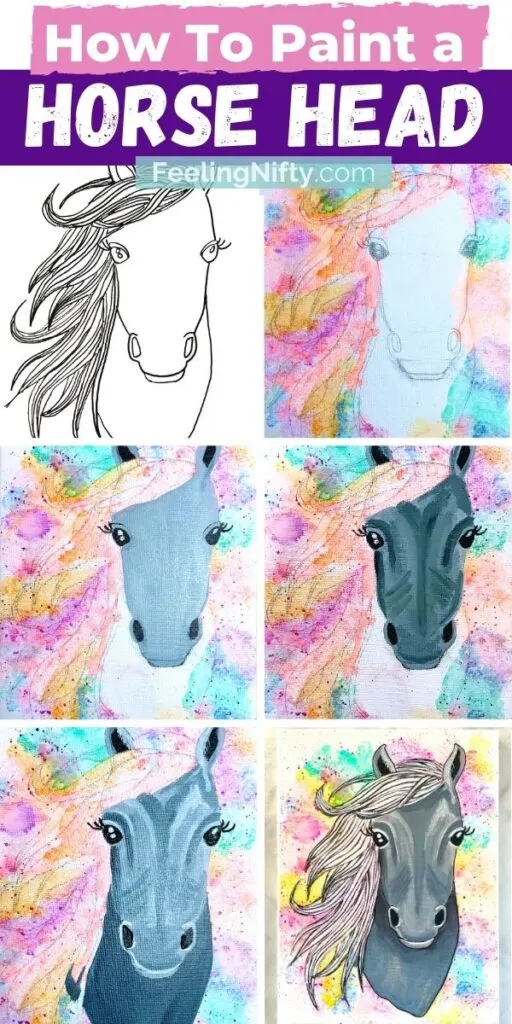Welcome to this “neigh”-mazing tutorial on how to paint a horse head using acrylic paints! If you’ve ever wanted to create an awesome piece of art but didn’t know where to start, this beginner friendly, step-by-step guide is perfect for you.
I’m going to break down the horse head into simple shapes and show you how to draw it like a pro. Plus, I’ll teach you how to paint the horses face, mane, eyes, snout, and mouth with the right dimensions so that it looks totally realistic. But wait, here’s the fun part: we’re going to add a funky abstract colorful background that’ll make your painting pop and stand out from the herd. So, “saddle up” and let’s harness your artistic skills to paint a beautiful horses head.
Before we begin, if you’re in the painting mood check out these easy acrylic painting ideas. Or if you want to piggy back of the magic of this painting you’ll love this moonlit mermaid painting tutorial.
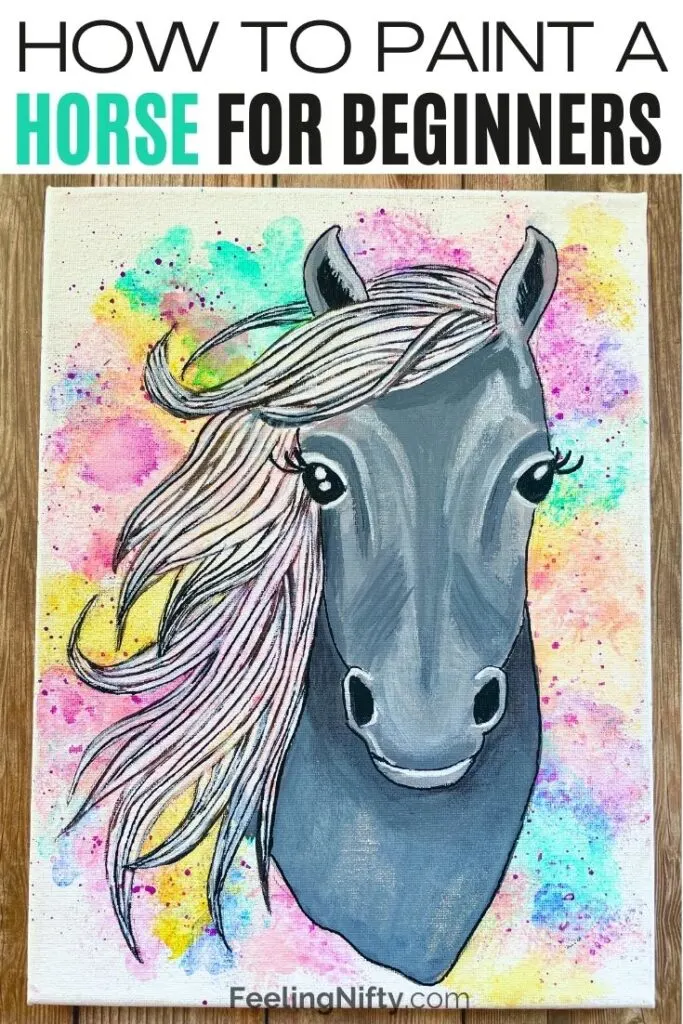
Choosing The Horse Reference Image
Alright, let’s talk about picking the perfect reference image for your horse head painting! As the brains behind this tutorial, I’ve got some experience in finding just the right picture to make the painting process a breeze.
So, here’s the scoop: I found this super cool drawing of a horse on Canva.com that totally looked like a painting. It had all the stuff I was looking for – clear details, good lighting, and simple shading. I wanted something that would be easy to mimic with paint, you know? Shading, highlights, and overall form – all that good stuff!

But hey, I get it. Not everyone feels confident drawing freehand. That’s why I’ve got your back! At the end of the blog post, I’ve included a free-printable traceable (scaled to use on a 9×12″ canvas size). You can just print it out learn how to trace it directly onto your canvas in this blog post. It’s like having your own personal guide.
Easy peasy!
If you’re up for a little adventure and want to pick your own horse picture, go for it! Just remember, simple pictures work best. Black and white ones are especially awesome because they make it easier to see different shades and highlights. Oh, and here’s a hot tip: check out this free photo website called Unsplash.com. They’ve got a ton of fantastic free horse pictures that are high-quality and royalty-free.
Now go ahead and find that perfect reference image that makes your heart race and your creativity soar.
How To Paint A Horse Head

Learn how to paint a realistic horse head with acrylics in this beginner-friendly blog post. With step-by-step instructions, visuals, and tips along the way, you'll bring your artwork to life!
Materials
- 9x12" canvas
- Mars Black
- Titanium White
- Assortment of acrylic paints of choice (yellow, pinks, green, orange, blue, purple, etc.)
- 1/2" Filbert Brush
- 1/4" flat brush
- Size 4 round brush (small detail brush)
- 1/2" Flat Brush
- Pencil
- Ruler
- Paper towel
- Jar of Clean Water
- Palette
Instructions
- Draw the horses head on canvas using a pencil. Note that the size of the reference cross is 7.5" x 3.5". For a full step by step how to draw a horse tutorial click here. Erase the reference cross when done the sketch before painting. Alternatively, you can print out the free-traceable at the end of this blog post and transfer it directly to canvas.


- Paint your watercolour-like abstract background. First, apply a smidgen sized amount of your assortment of acrylic paint colors (4-6 colors) to your palette. Now you're going to water each color down one-by-one so that they're liquid in consistency. Simply take your paint brush and bring some water into the paint and mix. Now take some of the watered down paint on your brush and blob it in areas around your canvas. This paint should be fully transparent and you should see the pencil sketch underneath. If you don't you need to water it down some more. You can also use a paper towel to blot the paint after it's applied to the canvas for a weathered look.
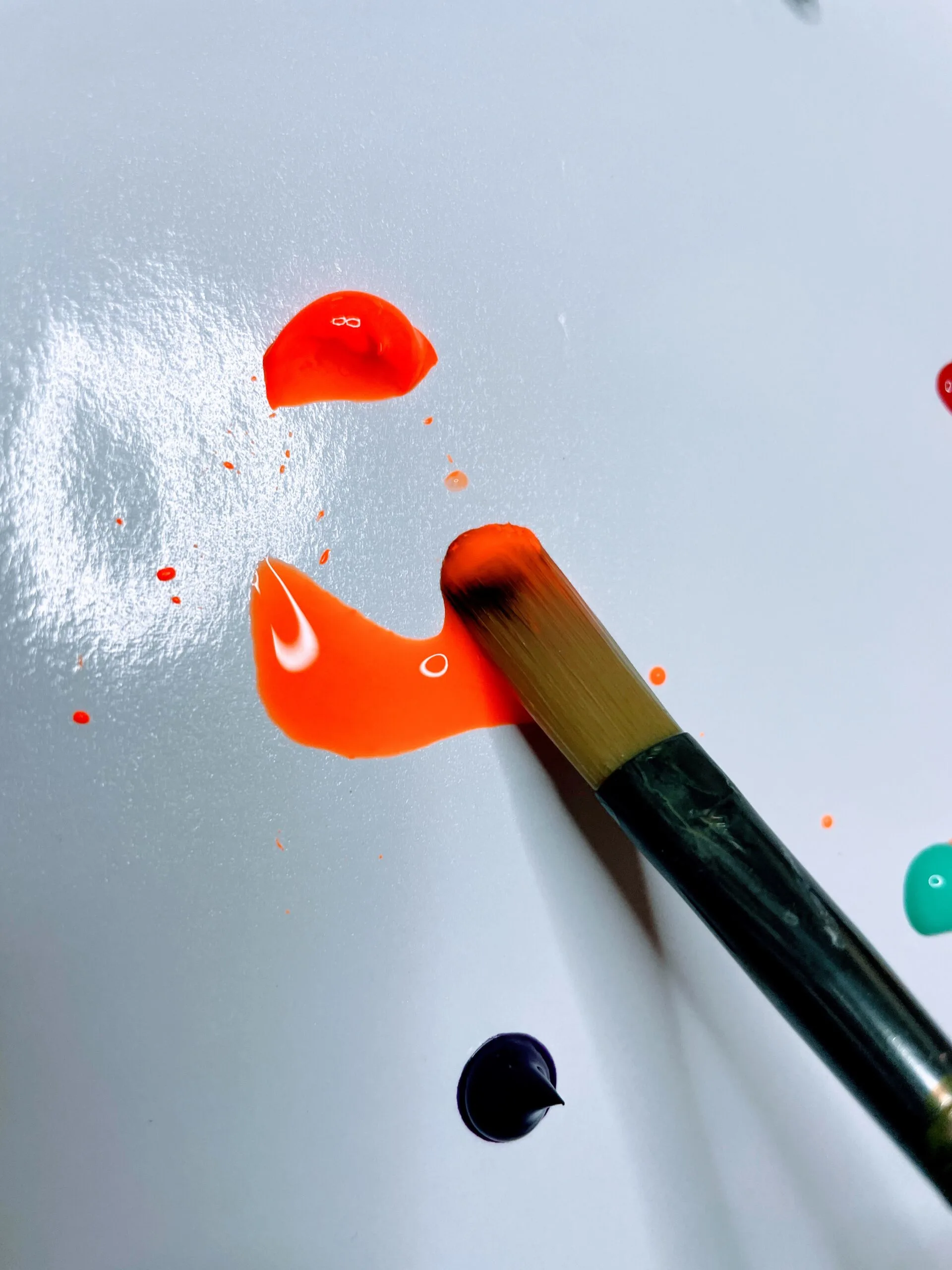

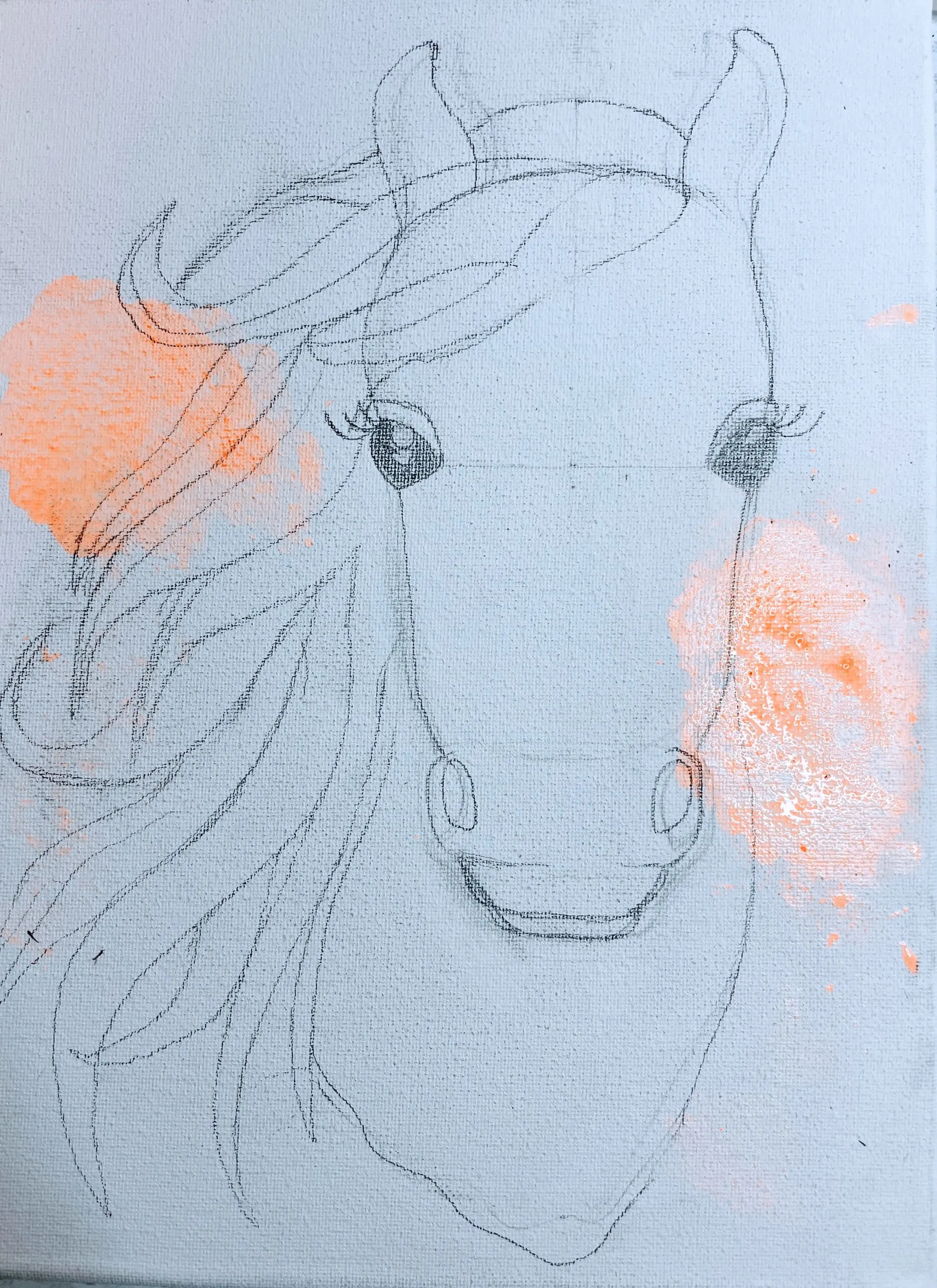
- Repeat adding different watered down colors all around your canvas. Make sure to cover the entire horses hair/mane with the paint. Leave some white space on the edges of the canvas. Don't worry if you get paint inside the horses face (you'll be painting over it in the next steps)

- Load any brush with the darkest watered down paint you have on your palette. Take another brush and then start tapping the paint loaded brush on it over your canvas. This will create a splatter technique to add interest to your abstract background.

- Fill in the eyes, eyelashes, eye crease, inner ear, nostrils, bottom part of mouth with mars black and your small detailing brush. You can thin down the black paint a little bit to make it easier to control (don't thin it to a liquid but rather a thick soup).
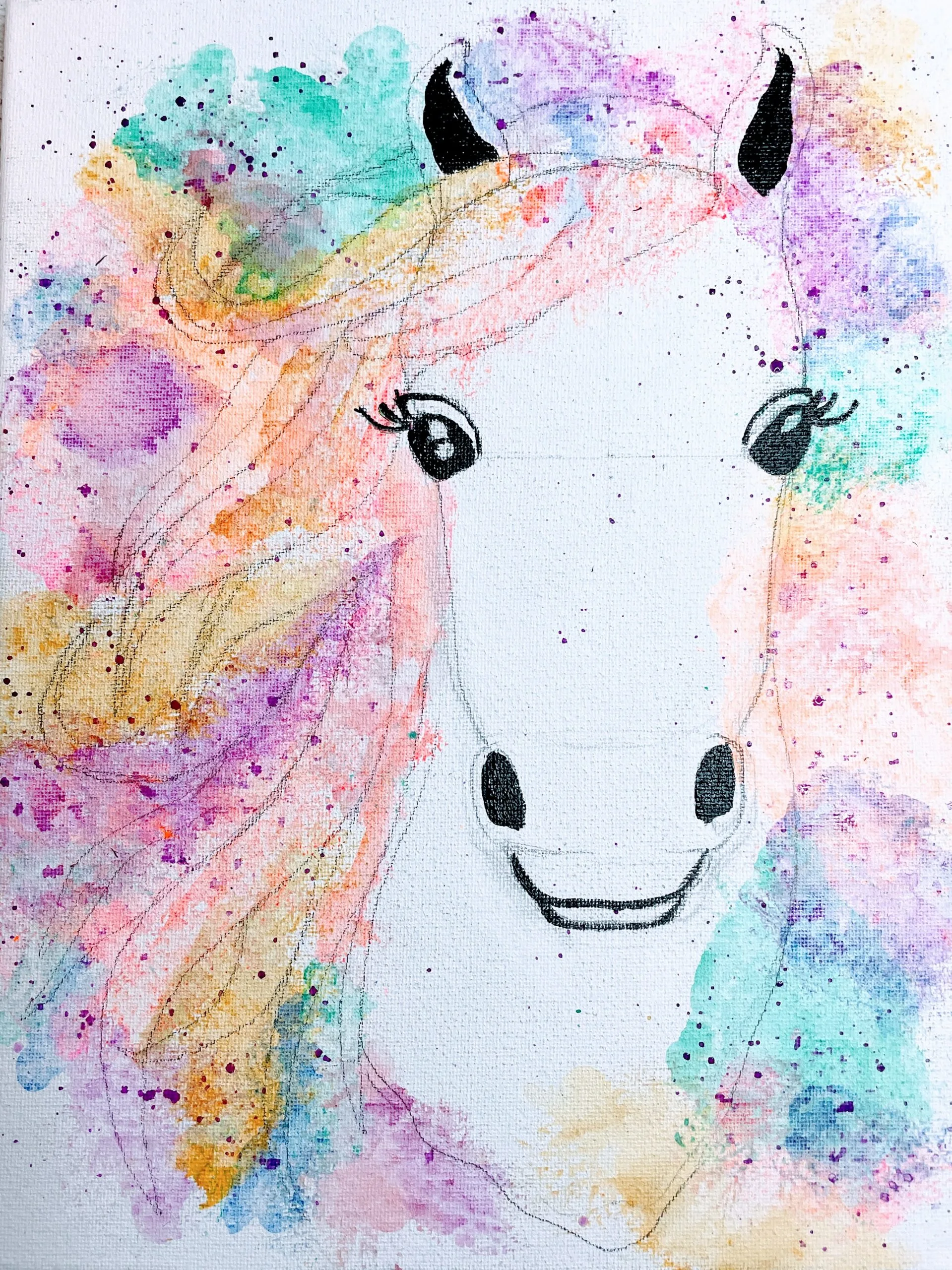
- Mix a grey paint with some titanium white and a tiny amount of black. The color should be a medium grey color. Paint the inside of the horses face with this grey paint, using the 1/2" flat brush. Wait until the paint is mostly dry before next step
 .
. - Mix a darker grey paint using your titanium white and mars black. There should be enough contrast between this shade of grey and the one currently on the horse. Using the 1/2" flat brush add your strokes of shadow to the horses face. The shadows are: down the center of the horses face, over and around each eye, the sides of the face, diagonal lines across the cheek, bottom of snout. top right of forehead. Wait for paint to fully dry.

- Using the same dark grey paint, apply the paint to the neck and body of the horse.
 .
. - Mix a light grey paint for the highlights (suing black and white paints). There should be enough contrast between the medium grey paint and this light one. Using your small round brush apply the highlights to the outside part of the ears closest to the centre, over and around the eyes (above the shadow), along the outside of the centre shadow down the face, around the outer edge of the nostrils, along the mouth.

- Take some black paint and using the chiseled edge of your 1/4" flat brush, trace along all the strands of hair. Use a thinner black paint with the same technique used in step 5 above.Wait for black paint to dry before moving on to next step.

- Using the small detailing brush, fill in the strands of hair with titanium white. Add the 3 white dots in the horses eyes to brighten up the eyes.

- Using some black paint and the chiseled edge of your 1/4" flat brush, trace along the outline of the horses head to give a "pop-art" effect.

- You're done!

Recommended Products
As an Amazon Associate and member of other affiliate programs, I earn from qualifying purchases.
-
 Liquitex BASICS Acrylic Paint, 118ml (4-oz) Tube, Phthalocyanine Green
Liquitex BASICS Acrylic Paint, 118ml (4-oz) Tube, Phthalocyanine Green -
 Liquitex BASICS Acrylic Paint, 13.5-oz bottle, Cadmium Red Medium Hue
Liquitex BASICS Acrylic Paint, 13.5-oz bottle, Cadmium Red Medium Hue -
 Liquitex BASICS Acrylic Paint, 118ml (4-oz) Tube, Fluorescent Orange
Liquitex BASICS Acrylic Paint, 118ml (4-oz) Tube, Fluorescent Orange -
 Liquitex BASICS Acrylic Paint, 118ml (4-oz) Tube, Fluorescent Pink
Liquitex BASICS Acrylic Paint, 118ml (4-oz) Tube, Fluorescent Pink -
 Liquitex BASICS Acrylic Paint, 118ml (4-oz) Tube, Cadmium Yellow Medium Hue
Liquitex BASICS Acrylic Paint, 118ml (4-oz) Tube, Cadmium Yellow Medium Hue -
 LIQUITEX Acrylic Paint Basics B-065, Titanium White, 4.0 fl oz (118 ml)
LIQUITEX Acrylic Paint Basics B-065, Titanium White, 4.0 fl oz (118 ml) -
 LIQUITEX Acrylic Paint Basics B-057, Mars Black, 4.0 fl oz (118 ml)
LIQUITEX Acrylic Paint Basics B-057, Mars Black, 4.0 fl oz (118 ml) -
 FIXSMITH Stretched White Blank Canvas - 9x12 Inch, Bulk Pack of 8, Primed,100% Cotton, 5/8 Inch Profile of Super Value Pack for Acrylics,Oils & Other Painting Media.
FIXSMITH Stretched White Blank Canvas - 9x12 Inch, Bulk Pack of 8, Primed,100% Cotton, 5/8 Inch Profile of Super Value Pack for Acrylics,Oils & Other Painting Media. -
 Strathmore 300 Series Palette Paper Pad, Tape Bound, 9x12 inches, 40 Sheets (41lb/67g) - Artist Paper for Adults and Students
Strathmore 300 Series Palette Paper Pad, Tape Bound, 9x12 inches, 40 Sheets (41lb/67g) - Artist Paper for Adults and Students
Frequently Asked Questions (FAQ)
Q: I’m a beginner and have never painted before. Can I still follow this tutorial? A: Absolutely! This tutorial is designed with beginners in mind. We provide step-by-step instructions and break down the process into manageable steps, making it accessible for painters of all skill levels. For another great beginner horse painting tutorial, check out Tracie Kiernan’s blog.
Q: Do I need any prior drawing skills to paint the horse head? A: Not at all! I’ve got you covered. If you’re not comfortable drawing freehand, I provide a free-printable traceable at the end of the post that you can use as a guide. Just print it out and trace it onto your canvas to get started.
Q: What materials and paints do I need for this tutorial? A: You’ll need basic acrylic painting materials such as brushes, acrylic paints, a canvas, and a palette. A detailed list of materials is provided in the how-to section of this post, so you can gather everything you need before getting started.
Q: Can I use different colors for the horse head instead of black and white? A: Absolutely! While we recommend using black and white for a realistic effect, feel free to experiment with different colors if you prefer a more creative interpretation. It’s all about expressing your artistic vision and making the painting your own.
Q: Can I share my finished painting with you? A: Absolutely! We would love to see your completed horse head paintings. Feel free to share them with me through social media on Instagram or join the private facebook group. You can also send them to me directly to [email protected]. I can’t wait to admire your artistic talent!
Finished Horse Head Painting



Free Horse Drawing Stencil Download
Right click on the image below and save to your device. Print on standard printer paper and transfer drawing to canvas.

If you liked this post please pin it on Pinterest
